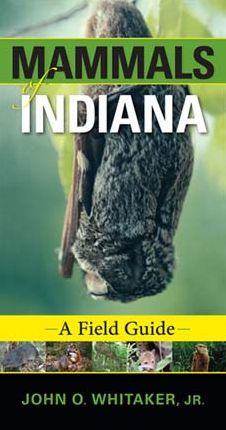

Paperback
-
PICK UP IN STORECheck Availability at Nearby Stores
Available within 2 business hours
Related collections and offers
Overview

Product Details
| ISBN-13: | 9780253222138 |
|---|---|
| Publisher: | Indiana University Press |
| Publication date: | 07/30/2010 |
| Series: | Indiana Natural Science |
| Pages: | 352 |
| Sales rank: | 1,110,141 |
| Product dimensions: | 4.20(w) x 8.20(h) x 0.80(d) |
| Age Range: | 18 Years |
About the Author
Table of Contents
Table of ContentsPreface and AcknowledgmentsIndiana's State Mammal—a ProposalIn Memory of the Recently Extirpated Native SpeciesSpecies of Questionable Recent OccurrenceSpecies List of Indiana MammalsIntroduction: Purpose and Plan of the BookIndiana: An OverviewThe Indiana LandscapeIndiana's Major HabitatsEcological Relationships of MammalsNaming and Identifying MammalsHow Mammals Are NamedHow Mammals Are IdentifiedUse of KeysIdentification KeysSpecies Accounts Listed by FamilyOrder DIDELPHIMORPHIA—OpossumsOrder SORICOMORPHA—Shrews and MolesOrder CHIROPTERA—BatsOrder CINGULATA—ArmadillosOrder LAGOMORPHA—Hares, Rabbits, and AlliesOrder RODENTIA—Rodents or Gnawing MammalsOrder CARNIVORA—Flesh EatersOrder ARTIODACTYLA—DeerEnglish-Metric Measurements ConversionGlossaryWorks CitedIndexWhat People are Saying About This
"Fifty-nine native mammal species currently live in Indiana, and eight species have been extirpated there. Whitaker (Indiana State Univ.) has produced a handsome, handy field guide for these midwestern mammals. This pocket guide has descriptions of all these species, including color animal and skull photos and distribution maps for each. Photos of habitats, trails, cuttings, burrows, nests, roosts, lodges, dams, mounds, pellets, and food items augment some descriptions . . . . The guide's sections cover landscape and habitats, mammal ecology, scientific names, mammal identification, instructions on using the keys, identification keys, and species accounts (by family). The keys include helpful drawings and photos to illustrate identifying features, though some figures could have been described in more detail in their legends. Each species account covers taxonomy, distinguishing features and measurements, skull, dental formula, habitat, food, reproduction, range, habits, and comments. The guide concludes with a metric measurements conversion table, comprehensive 20-page glossary, extensive citation list, and relatively brief index. The book's stated purpose is to help people identify Indianan mammals, and the combination of text, photos, and maps therein should allow any reader interested in midwestern mammals to do so. Summing Up: Highly recommended. Academic and general audiences, all levels; mammalogy professionals. — Choice"
John Whitaker is certainly the person to write this book! His long career dedicated to study of the mammals in Indiana and his experience in writing books such as this put him in excellent position to author this book.
Fifty-nine native mammal species currently live in Indiana, and eight species have been extirpated there. Whitaker (Indiana State Univ.) has produced a handsome, handy field guide for these midwestern mammals. This pocket guide has descriptions of all these species, including color animal and skull photos and distribution maps for each. Photos of habitats, trails, cuttings, burrows, nests, roosts, lodges, dams, mounds, pellets, and food items augment some descriptions . . . . The guide's sections cover landscape and habitats, mammal ecology, scientific names, mammal identification, instructions on using the keys, identification keys, and species accounts (by family). The keys include helpful drawings and photos to illustrate identifying features, though some figures could have been described in more detail in their legends. Each species account covers taxonomy, distinguishing features and measurements, skull, dental formula, habitat, food, reproduction, range, habits, and comments. The guide concludes with a metric measurements conversion table, comprehensive 20-page glossary, extensive citation list, and relatively brief index. The book's stated purpose is to help people identify Indianan mammals, and the combination of text, photos, and maps therein should allow any reader interested in midwestern mammals to do so. Summing Up: Highly recommended. Academic and general audiences, all levels; mammalogy professionals. — Choice
Fifty-nine native mammal species currently live in Indiana, and eight species have been extirpated there. Whitaker (Indiana State Univ.) has produced a handsome, handy field guide for these midwestern mammals. This pocket guide has descriptions of all these species, including color animal and skull photos and distribution maps for each. Photos of habitats, trails, cuttings, burrows, nests, roosts, lodges, dams, mounds, pellets, and food items augment some descriptions . . . . The guide's sections cover landscape and habitats, mammal ecology, scientific names, mammal identification, instructions on using the keys, identification keys, and species accounts (by family). The keys include helpful drawings and photos to illustrate identifying features, though some figures could have been described in more detail in their legends. Each species account covers taxonomy, distinguishing features and measurements, skull, dental formula, habitat, food, reproduction, range, habits, and comments. The guide concludes with a metric measurements conversion table, comprehensive 20-page glossary, extensive citation list, and relatively brief index. The book's stated purpose is to help people identify Indianan mammals, and the combination of text, photos, and maps therein should allow any reader interested in midwestern mammals to do so. Summing Up: Highly recommended. Academic and general audiences, all levels; mammalogy professionals. — Choice
